11043 A TULIP POKAL BY SIMON LANG AND MARKED WITH THE HEBREW LETTERS ‘ALEPH SHIN ALEPH’ Nuremberg. Circa 1660. Measurements: Height: 9 1/2″ (24.1 cm) Depth: 4″ (10.2 cm)
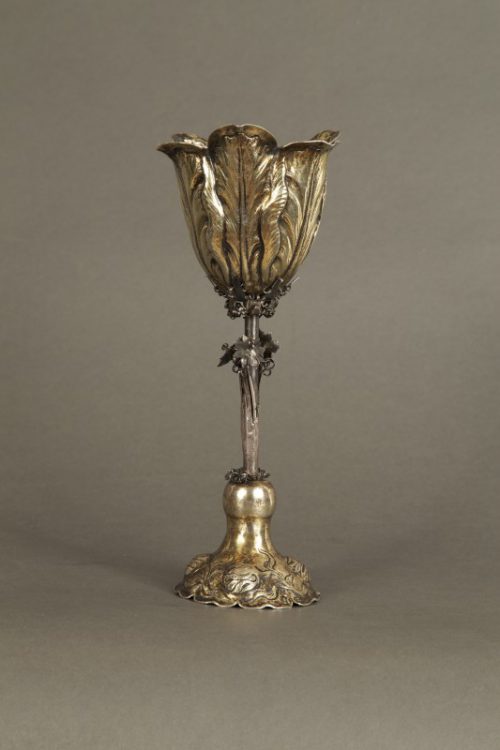
Research:
Of parcel-gilt silver. With tulip cup upper section resting upon a naturalistically cast stem issuing flowerheads and tendrils. The splaying base with stylized flower cast decoration.
Marks:
Bears the silver hallmarks for Simon Lang and Nuremburg.
Marked at the base with a Hebrew inscription of unknown meaning.
This type of vessel is called a pokal, “one of the most spectacular and characteristic types of secular treasures fashioned by the Renaissance goldsmiths active in Augsburg, Nuremberg, and elsewhere in Germany.”1 Although defined simply as a cup on a high stem, “the term is usually reserved for a goblet of some distinction, suitable for ceremonial purposes or presentation, and fitted with a cover.”2 Indeed, these vessels were not mass-produced or made for daily use, but were given as diplomatic presents and reserved for special ceremonies. “Rich burghers [also] exchanged them as wedding gifts or retained and cherished them as reminders of their own wealth and lofty social status.”3
The present piece bears the silver hallmarks for Simon Lang and Nuremburg. Lang (c. 1608-1671) was a goldsmith made master in Nuremberg on August 24, 1645. Guild membership required a candidate to submit a gold ring, seal-die, and masterpiece pokal before their acceptance as a master goldsmith. It was not until he reached the age of 37 that Lang began working on his masterpieces. Nevertheless, a number of his works, among which shell-form pokals are particularly well represented, have survived.
Our example takes the shape of a tulip; the main flowerhead forms the upper cup section and rests upon a naturalistically cast stem issuing flowerheads and tendrils. The splaying base is decorated with stylized flower cast decoration. The upper section, stem, base and tendrils were all cast separately and fasten by being screwed together. Tulip-form cups were popular in the second half of the 17th century and were apparently a specialty of the Nuremberg Goldsmiths.
The tulip is not native to Europe, but was introduced from the East via the Ottoman empire to the Habsburg court in the late 16th century. The first mention of the flower appears in 1554 in the correspondence of Oghier Ghislain de Busbecq, ambassador of Ferdinand I to Suleyman the Magnificent. “Tulipomania,” as the craze for this flower was called, reached its zenith in Europe in the first half of the 17th century, aided by the spread of botanical compendia and engravings. The exotic bloom, unlike any other in Europe, soon became a luxury item and status symbol, and “tulips were much sought after by the wealthy, especially in Holland and Germany.”4 The most rare and highly prized were “broken” tulips, specimens that had been affected by a tulip mosaic virus which caused dramatic streaks of two separate colors on its petals. The subtle pointillé (punched) lines of the petals on the present cup are reminiscent of this aesthetic phenomenon. Figure 1 illustrates two related examples of this as it appears on the most coveted broken tulip, the Semper Augustus, from the Brandemandus Tulpenbuch (tulip book), an album containing sixty-two gouaches of 121 varieties of tulips, produced circa 1637, today in the Stedelijk Museum Het Prinsenhof, Delft.
The base of the present pokal is inscribed with the Hebrew letters ‘aleph shin aleph’ (A Sh A), most likely representing the initials of the owner.
Footnotes:
1. Winters, Laurie, Joseph R. Bliss, Charles Avery, Russell Bowman, Richard Flagg, and Erna Flagg. A Renaissance Treasury: The Flagg Collection of European Decorative Arts and Sculpture. New York, NY: Hudson Hills Press [u.a., 1999. 63.
2. Dauterman, Carl C, and F J. B. Watson. Furniture ; Gold Boxes ; Porcelain Boxes, Silver. New York: Metropolitan Museum of Art, 1970. 445
3. Winters, 63.
4. Mackay, Charles (1841). Extraordinary Popular Delusions and the Madness of Crowds. Petersfield, Hampshire: Harriman House Ltd, 2006. Internet resource. 105.4
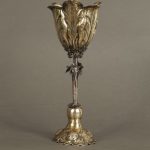
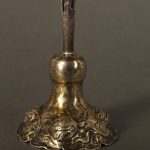

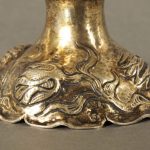
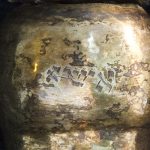
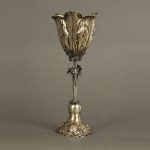
Comments are closed.